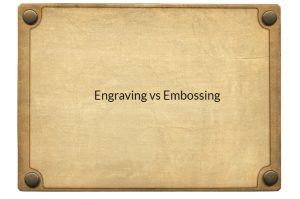How Engraving and Embossing Differ: Details, Technique, Durability
Engraving and embossing are two historically important techniques for creating images, text and intricate designs on a wide range of materials. They are still used to this day for signs, plaques and labels, but what exactly sets these manufacturing processes apart?
 Here, we’ll explore the differences and find out why engraved designs offer a detailed, durable solution.
Here, we’ll explore the differences and find out why engraved designs offer a detailed, durable solution.
Engraving Explained
Engraved designs are produced by precisely removing material in order to create an inscription or sign. An engraved laminate, for instance, can be affixed to a machine warning workers of the relevant dangers. This laminate plastic – commercially known as Traffolyte – is just one of many materials that can be incised using hand tools, lasers and CNC machines by Able Engraving and Design Ltd. Bronze, stainless steel and brass, to name a few, are all commonly used by their experts to make nameplates and plaques.
How Is Embossing Different?
Embossing is similar to the engraved methods, in that both techniques are used to create depth in a material, whether that’s for a design or lettering. However, while an engraved style is achieved by removing trace amounts of material, embossing uses a die that raises the material – card, sheet metal, tin – to the same level from beneath, or varying levels using a multi-level die, to create a 3D impression. Business cards, leather belts and tags, and wedding invitations are all often embellished using this technique.
It’s All In the Details
Embossing is the quicker of the two methods for creating a marked design. However, laser engraved products, in particular, offers a greater and more striking level of detail that can be seen and felt. A CNC machine, for instance, allows professional engravers at Able to complete complex logos and imagery on any size material, whereas embossed designs tend to blur and compress in small areas.
A Lasting Design
Engraved designs and lettering are less likely to fade or degrade over time because they’re recessed and, therefore, protected from the elements. Further to this, a laser etching will offer a more durable contrast. On the other hand, an embossed logo or design is very much exposed to the elements and, consequently, any damage or degrading may make the design illegible. On leather, for example, if the right type of material isn’t used then the embossing will fade.
